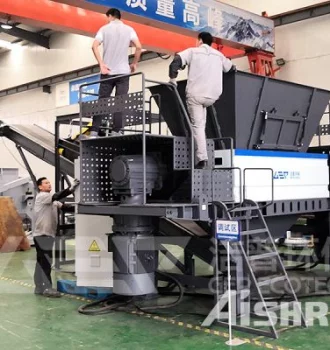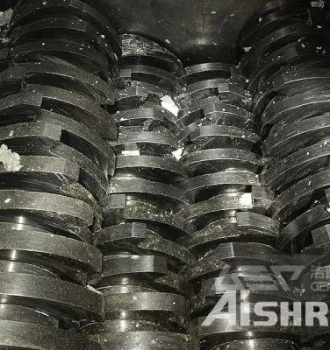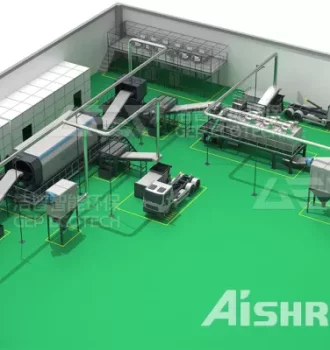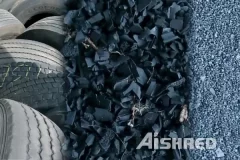
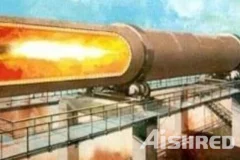
Conventional fuels like hard coal and lignite that are commonly used fuels in cement production have high specific CO2 emission values (Hard coal: ~95 kg CO2/GJ; Lignite: ~98 kg CO2/GJ). Consequently, substituting these with other fuels having lower specific emssion values (e.g. fuel oil or natural gas) or with other sources that can satisfy the thermal demand of the processes is an effective way of reducing CO2 emissons. Principally, in cement kilns conventional fossil fuels can be substituted up to 100% by alternative fuels. Nevertheless, there are certain technical limitations like the calorific value, the moisture content, and the content of side products like trace elements or chlorine. The calorific value of most organic material is comparatively low (10 – 18 GJ/t). For the main firing of the cement kiln an average calorific value of at least 20-22 GJ/t is required, meaning that high calorific alternative fuels are mostly used in the main firing. Waste tyres can be used as a fuel in cement kilns. Waste
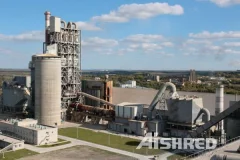
Co-processing Waste in Cement Industry
2022-04-21The problem of waste is one of the most urgent on the world agenda, According to the World Bank, the world generates 2.01 billion tonnes of waste every year, with at least 33 percent of that—extremely conservatively—not managed in an environmentally safe manner. Therefore, the most important task is to clear the waste and create a system that will allow separating waste, competently managing its flows, processing it and without harm to nature. Turning the so-called “tailings” into cement, which remain at the waste sorting complexes after the extraction of all useful recyclable materials, is one of the most environmentally friendly and effective solutions to this problem. The use of alternative fuels from municipal solid waste (MSW) in cement production will help global achieve environmental goals.Waste Disposal in the Production of CementLimestone, clay and thermal energy are needed to make cement. The cost of the latter is 30% of all production costs. The cement industry uses a variety of fossil fuels to
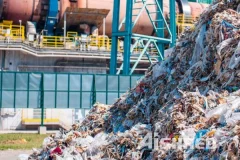
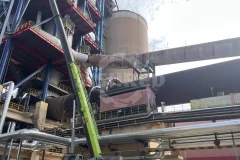
Due to the continuing energy cost fluctuations and the discussions on the sustainable protection of resources the cement industry has hardly enabled to reduce its entire energy and power demand as a result of technical optimisation of its cement production. With the rising energy prices, people have successively used petroleum and coal as the main fuel for cement production. Later, people began to explore the use of waste oil and tires. Nowadays, as people pay more and more attention to reducing carbon emissions, the waste-to-fuel technology has become more and more mature, and many cement kilns have begun to use municipal solid waste or industrial and commercial waste as alternative fuels.Substituting Coal and Petcoke with Alternative fuelsCoal and petcoke, two of the most carbon-intensive fuels, are typically used to heat cement kilns. The substituting coal with lower-carbon fuels offers the greatest short-term potential to reduce CO2 emissions in the industry. Most alternative fuels have a lower carbon
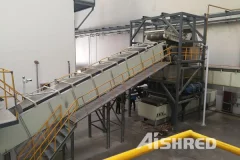

Industrial Shredder for Cement Industry
2022-04-06Cement production is an extremely energy-intensive process that emits approx. 8% of the world’s CO2. There are huge economic and environmental benefits to be made by replacing fossil fuels with alternative fuels made from waste. Cement producers utilizing alternative fuels such as refuse-derived fuel (RDF) and solid recovered fuel (SRF) can gain a substantial competitive edge. In many cases, however, input waste streams contain diverse materials not suitable for co-processing in the cement kiln. A well-designed alternative fuel production process ensures the best quality. To maximize energy production with the lowest possible emissions, a homogeneous grain size, high calorific value, controlled material composition, removal of fines, low chloride and a stable humidity content are a must. Opening waste bags and reducing the size of waste by pre-shredding ensures that unwanted items can be screened and separated from the process. Later in the process, when you have achieved an optimal material content for the
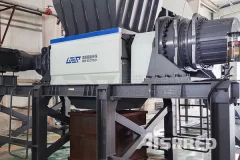
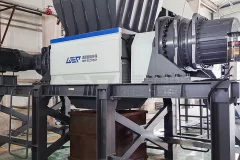
Many processes of co-processing municipal solid waste in cement kilns mostly adopt the method of shredding the waste and then incinerating it in the kiln. Since the municipal solid waste is mixed waste, in order not to affect the cement clinker calcination process and product quality, improve the acceptance ability and control ability of the cement kiln system, shredder machine must be set up. So what kind of shredder is used for pre-processing and co-processing MSW in the cement industry? Today, I recommend a GD series MSW shredder for your reference. GD series double-shaft shearing MSW shredders use the principle of mutual shearing and tearing between two relatively rotating knives to shred materials. Adopt "double motor + double planetary reducer", with strong power and high running stability. It is often used in environmental protection fields such as municipal solid waste disposal, resource regeneration, and waste incineration pretreatment. The equipment has the characteristics of low speed, large

